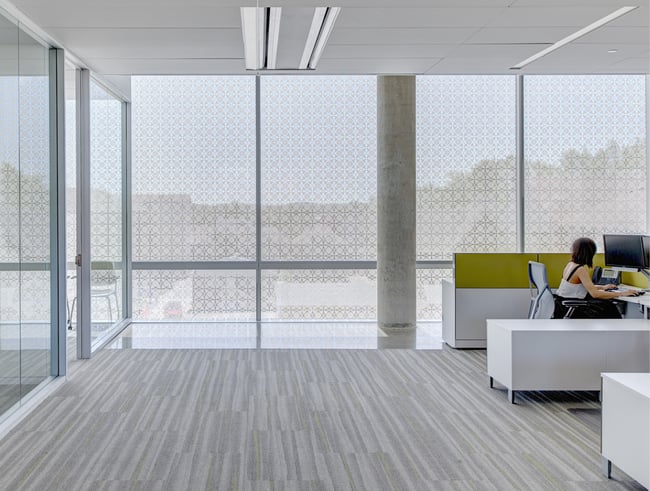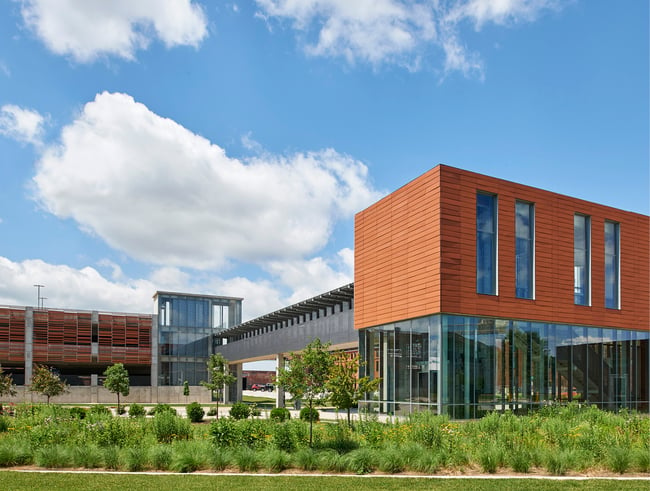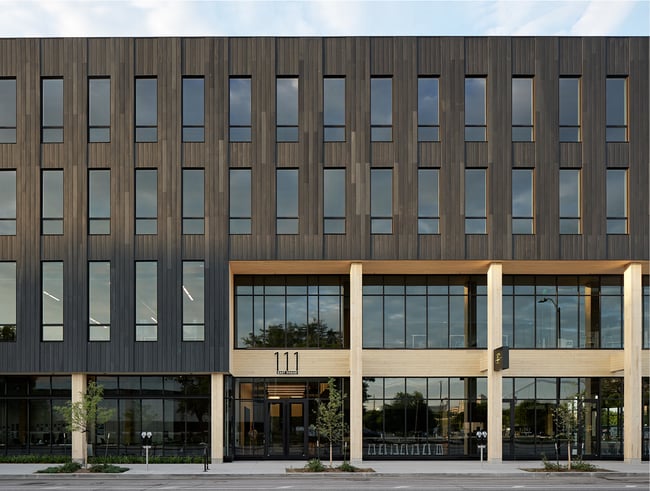Factors to Consider When Selecting Exterior Building Materials

Exterior material selection is a crucial decision during the architectural process. While defining the building’s character, exterior materials protect the building from weather, moisture, and changing temperatures. The quality of your choice has a lasting impact on your maintenance and operating budget.
We’ve guided countless commercial clients through the architectural process—from K-12 schools and universities to corporations and hospitals. In our experience, an owner should consider several factors when selecting exterior materials, including:
- Initial and life-cycle costs
- Building type and height
- Aesthetics and visual identity
- Climate
- Resiliency and durability
- Thermal and acoustic performance
- Installation and testing
- Sustainability
This article will discuss these factors in greater detail, preparing you to choose a material appropriate for your project.
8 Exterior Material Considerations
1. Initial and Life-Cycle Costs
Initial costs are perhaps the most obvious consideration when selecting exterior materials. Ideally, you will find a quality option within your construction budget.
Although initial costs may be top of mind, you should also consider the life-cycle cost—the total cost of owning, operating, maintaining, and disposing of a material. Generally, materials with a lower initial cost present higher life-cycle costs.
Investing in durable, high-quality materials is the best way to lower the long-term cost of building ownership. Your architect can help you understand the long-term implications of a potential selection with a life-cycle cost analysis.
2. Building Type and Height
Building type and height are other primary considerations when selecting exterior materials. Code requirements will guide decision-making down a set path, narrowing your options.
Beyond code requirements, consider how the building’s size will impact maintenance. Generally, high-rise buildings should avoid high-maintenance materials requiring sealants and paints. Curtainwall and unitized systems that hang from the building’s slab have less upkeep, making them the recommended option.
Taller buildings may present additional challenges related to glare and bird safety. Design teams should consider how material choices will impact surrounding buildings and use bird-safe glass to protect wildlife.

Patterned bird-safe glass can protect wildlife.
3. Aesthetics and Visual Identity
While choosing materials appropriate for the building’s height, consider the building’s visual impact. Exterior materials define a building’s identity, and the pursuit of beauty should guide decision-making.
Design teams and clients should also consider how the building responds to existing structures. Whether for ecological or historical reasons, specific materials tend to dominate different regions.
For example, downtown Iowa City contains many distinctive red brick structures due to the historical presence of a nearby brick plant. Similarly, cedar siding is a common sight in the Pacific Northwest because of the area’s ecology and material supply.
When crafting a building’s visual identity, explore historical precedents and find ways to harmonize with existing buildings. The goal is to maintain a dialogue with older architecture, not copy it.
4. Climate
Studying historical precedents can also help you find materials appropriate for your local climate.
Materials that work well in some regions can pose problems in others. In the Midwest, we face extreme seasonal temperature changes and high humidity. Rain screen systems are a common way to protect interiors from moisture.
Buildings in the Southwest take a different approach. To absorb heat and temper the building’s cooling needs, designers tend to specify high-mass materials.
Exterior materials guard the building against Mother Nature, and it helps to stick with tried-and-tested solutions for your region.
5. Resiliency and Durability
Similarly, it helps to consider how materials will hold up against less-than-ideal weather conditions. The best products are resilient to natural disasters or can be easily replaced in an unforeseen event.
The right approach depends on your region and the type of weather events you are likely to encounter. In the Midwest, you may select hardened materials to withstand high winds and tornadoes. Buildings in more tropical regions should consider flood resistance.
We also recommend considering how the material will age over time. Wind, rain, and sun take a toll on a building’s exterior, and even the most durable materials will experience wear.
Some materials weather better than others. For example, more natural materials like brick, stone, concrete, or weathering steel will change over time and develop a patina. Other materials, like metal panels, will need to be replaced as they wear.
No building will look the same forever. When selecting materials, consider if they will stand the test of time.

Natural materials like terracotta tend to stand the test of time.
6. Thermal and Acoustic Performance
Exterior materials can impact occupant comfort inside the building. Design teams should consider thermal performance and a material’s ability to resist energy movement. Thermal performance should be balanced with other considerations, like daylighting and views, and your design team should set realistic expectations about the system’s performance.
Additionally, you may consider the material’s acoustic performance. Some buildings—like those near busy roadways, airports, train tracks, or power generation stations—may need to mitigate sound transmission. Generally, solid materials are the best for resisting exterior sounds, but PVB (Polyvinyl Butyral) layers can be added to glass to improve performance.
7. Installation and Testing
Local labor availability and contractor knowledge can impact exterior material choices. To simplify construction, limit options to those with skilled labor availability.
This consideration may impact some regions more than others. In more urban areas, for example, you are more likely to find contractors familiar with your material choice.
Along with skilled labor availability, your design team should consider testing and how it will impact your construction timeline.
8. Sustainability
Finally, design teams and clients should consider a material’s environmental impact.
One way of determining a material’s environmental impact is to analyze its embodied carbon. Embodied carbon refers to the total emissions released during the life cycle of a building or system, including its manufacturing, transportation, maintenance, and disposal. Tools like the Tally Life-Cycle Assessment can help determine the total emissions released by a material option.

Carbon-sequestering materials like wood have lower embodied carbon levels.
You should also consider the material’s longevity. Durable and naturally aging materials—like brick, stone, and concrete—are less likely to end up in a landfill. Considering life cycle costs, maintenance, and resiliency will lead to more long-lasting options.
Prepare for Interior Material Selection
Material selection occurs on every building project. Although the design team will present options and guide decision-making, choices come down to the client, their budget, and their goals.
Exterior materials are a crucial decision. In addition to defining the building’s identity, your choice has a lasting impact on your maintenance and operating budget. Materials should be appropriate for your building type and climate while providing durability, resiliency, and low life-cycle costs.
Later in the design process, you will select interior materials, including flooring, casework finishes, and countertops. These materials present their own set of considerations, including maintenance and cleanability. Learn more by reading our tips for selecting interior materials.